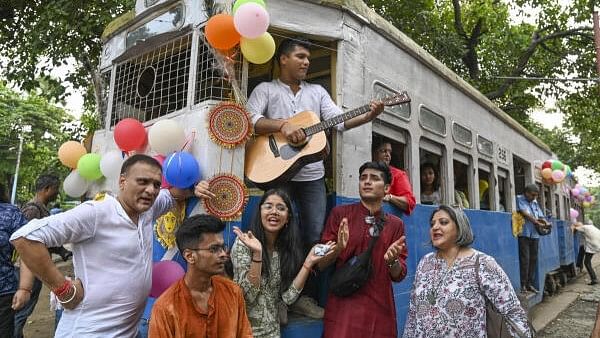
Tram lovers perform a song as part of a campaign to save tram services in the city, at Esplanade tram depot in Kolkata.
Credit: PTI Photo
The news that Kolkata’s 150-year-old tram service is being stopped brought home a stab of sadness. Other cities too had trams, but I didn’t live in them, and they were stopped long before I got used to travelling in them, as I did in Kolkata. In my childhood and young womanhood, that is, through school and college, the trams of Kolkata were an integral part of life.
Initially, my brother and I would board a tram only with a parent, but when I started going to college, I was permitted to travel on these “line beauties” alone. With their diamond-shaped antennae stuck to the electric lines above and restricted to the tracks below, these trams were definitely not monsters of speed; they were more like lazy caterpillars. My tram, Route No. 29, would stop with the familiar hoot at the Rash Behari Avenue and Sarat Bose Road junction, where I would board to go to my college on Shyama Prasad Mukherjee Road. I would use other routes to visit my friends in Tollygunge and sometimes go all the way to what used to be the centre of the city, Victoria House, where my father worked for decades.
The trams had two carriages, divided into two classes! The gentry travelled “first class,” and the workers took the second class. That may explain the political leanings of the state! There were wooden seats and heavy, cumbersome iron fans, which served to move the heavy, humid Kolkata air along. The shutters, made of wood, were rickety but were seldom noticed. The trams ferried all kinds of people along, from the bhodro lok (gentry) to the impoverished who found this cheap, if slow and clanking, mode of transport convenient. Several big round bamboo baskets often accompanied the passengers.
I sometimes looked at the parallelograms of the tracks near the Kalighat Depot and the network of wires above and wondered how the trams kept to the right tracks. I soon gave up wondering, supremely confident of the tram drivers’ skills. And, indeed, I cannot recall a single instance of a traffic accident that involved our beloved trams!
Did I, moving along in these old carriages, think of the day when they would be no more? I did not. To me, the trams were a permanent feature of Kolkata. Recently, I visited Kolkata and took a short ride in the tram, just for the fun of it and the joy of experiencing that lasting connection to my childhood. The tram was crowded, but the sight of a Bangali Babu with his dhuti and kurta and the shaankh and pola of the ladies made me feel right at home.
The trams of Kolkata, except for one short token ride, will fade into history. I bid them a fond adieu, as an unbidden tear rolled down my cheek, for the halcyon, slow-moving traffic and far-less-congested roads of the city of my youth, Kolkata.